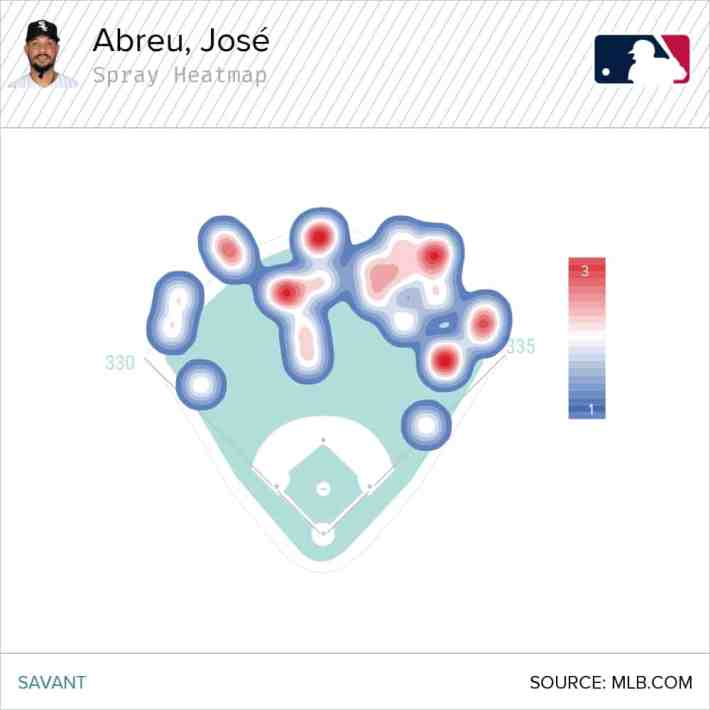In the fifth inning in Tuesday's game, José Abreu came to the plate with the bases loaded, one out, and the potential to turn a 3-0 lead into something insurmountable. Instead, he grounded into a 6-4-3 double play to end the inning.
Abreu, who has led the league in double plays three years running, avoided this column for the first 18 games of the season. He has since grounded into DPs in three of his last five games, putting him back on a 20-something pace.
Yet this one wasn't a routine double play, even setting aside the fact that Wrigley Field played more like the Westfjords. Abreu pounded the grounder at 106.5 mph, and required a great play by Nico Hoerner to start the double play with a cross-body throw to second, so you could argue it's a different form of the same bad luck that has plagued Abreu throughout the season.
The White Sox have been affected by the deadened baseball more than most, and they've been all over the articles about the unluckiest starts. Baseball Prospectus ran the most recent one today, using it as fodder for potential buy-low/don't-sell candidates, and the White Sox got their own entire section thanks to Yasmani Grandal, José Abreu and Luis Robert all appearing on the list of players shortchanged by their barrels.
Similarly, José Abreu is walking more than he ever has while striking out less than he has since 2017, thanks in part to his lowest chase rate ever. And it’s not just because of deciding to be passive at the plate, like it can be with hitters who show spikes in these areas. His overall swing rate is in the same ballpark it’s always been. With each of these two being well into their 30s, maybe you can find an antsy leaguemate and add one of them to your squad before their contact profiles start creating more offense.
It makes sense to compare the expected slugging percentage to the actual SLG number and expect regression to fill in the rest over the coming weeks, but as Tom Tango, one of Statcast's lead architects, told Baseball Prospectus a few years ago, these stats weren't meant to be predictive:
Tango then stressed that the expected metrics were only ever intended to be descriptive, that they were not designed to be predictive, and that if they had been intended to be predictive, they could have been designed differently or other metrics could be used. Having thought about this, we have a few comments.
First, defining “expected” performance entirely in terms of past performance is a tough sell, regardless of what you intended. Grammatically speaking, it seems like a better name for these metrics would be What You Would Have Expected wOBA (wywhewOBA) rather than the more general “expected” modifier, a concept, together with its “x” prefix, that is indelibly—as well as logically—associated with anticipated future performance among fantasy baseball enthusiasts and others.
And right now, Abreu is a cautionary tale. His xSLG is still a robust .581, good for a 90th-percentile standing in Statcast, but that number has been falling, in part because his ground-ball rate has been rising.
Statcast doesn't filter by date ranges, but fortunately enough tweets have emphasized Abreu's unluckiness that his xSLG can be referenced on given dates, and we can compare it to his season ground-ball rates at the time of the snapshot. As you might expect, there's a negative correlation.
| Date | SLG | xSLG | GB% |
| April 17 | .364 | .860 | 39.1 |
| April 22 | .341 | .726 | 43.8 |
| April 25 | .392 | .654 | 44.7 |
| Now | .329 | .581 | 51.6 |
Sure, a 250-point gap between expected and actual slugging percentages is still large, but it used to be nearly 500 points when his loudest contact came with strong launch angles, so the decrease in Abreu's contact quality is also dragging down his xSLG, even if it doesn't look like it.
In order for a player to catch up to his early xSLG numbers, he has to shoulder the responsibility to continue to look like that player. Otherwise, it risks being a month where he couldn't capture his best possible results for one reason or another, giving his actual numbers nothing to buoy whatever he does afterward. Abreu is in a rut where he's beating more and more pitches into the ground, and it's difficult to produce more than the occasional double that way.
And even if this is a temporary ground-ball rut, a BPro article about Marcus Semien's abysmal start published Tuesday lays out the idea that players whose best contact travels to center field are bound to be uniquely hurt by the deadened baseball. That's the part of the field Abreu's best batted balls routinely explored early in the season.

Abreu started the year by hitting more fly balls than ever before. That's still the case, but now he's hitting more grounders than ever before. The line drive rate has been the collateral damage, as it's dropped into the single digits (9.7 percent), nearly one-third of his career rate (27 percent). He's dropped into an all-or-nothing approach, and the current environment, those giving their all aren't getting a fair return.
This isn't necessarily alarmist. Abreu has made his displeasure for the cold clear, and this first month's weather has regularly produced barely playable conditions. If he eventually syncs up his swing on fastballs, he could make this moot. Or the league could change the baseball in the middle of the season like they've done before, and the offensive environment could swing drastically month to month, with Abreu happy to go along for the ride.
For the time being, Abreu has seven RBIs through 22 games, which puts him well behind the pace everybody has been accustomed to. It's the lowest total of RBIs by far at this point in the season.
- 2014: 21
- 2021: 172019: 17
- 2015: 15
- 2020: 13
- 2018: 12
- 2017: 11
- 2016: 10
- 2022: 7
There are a few ways out of this rut, and history says Abreu will be able to figure it out. I'd just caution against pointing only to the expected slugging stats, at least during times where his swing and its results are living down to expectations.






